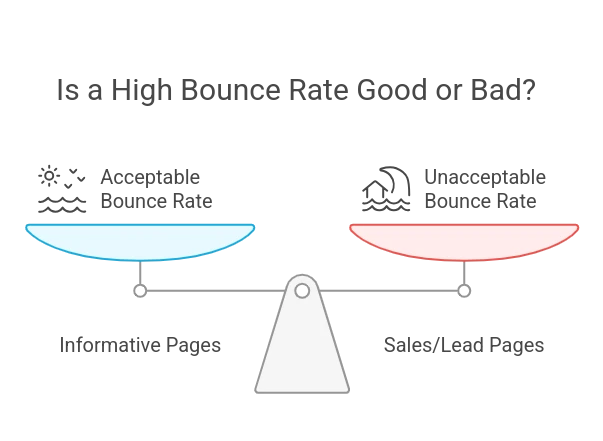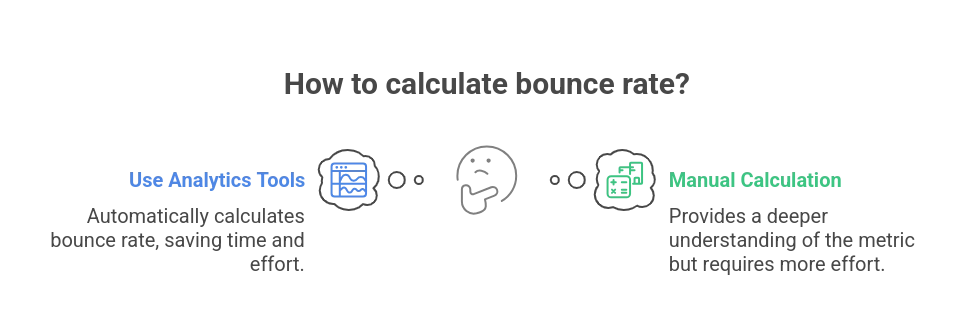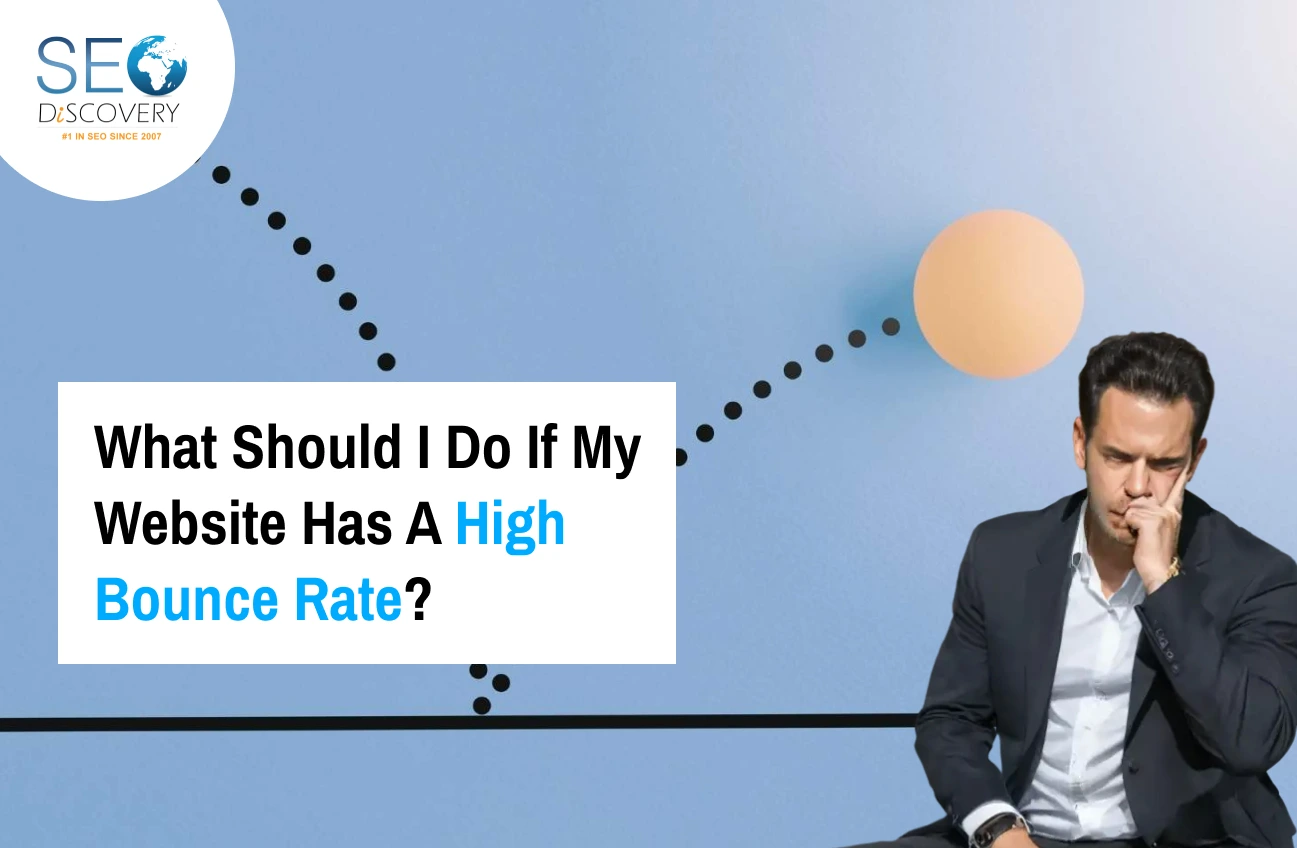Having a website is great, but what if people visit and leave without doing anything? This is known as a high bounce rate, and it’s a common problem for many website owners. A high bounce rate means visitors are landing on your page but quickly leaving without exploring more or taking any action. This can affect your business because fewer people are staying to learn about your products or services.
There are many reasons why people might leave your site quickly. It could be that your website takes too long to load, is hard to navigate, or doesn’t give them the information they were expecting. Whatever the reason, a high bounce rate is a clear sign that something on your site needs attention.
The average website bounce rate is around 50%. For some types of sites, like blogs or news, it can even go as high as 70%.
That means more than half of your visitors might be leaving without engaging. The good news is, there are simple ways to fix this. Partnering with the best SEO company can also help you optimize your site, improve user experience, and ensure that your visitors stay longer and engage more with your content.
In this blog, we’ll explain what you can do if your website has a high bounce rate and how to keep visitors interested.
Table of Contents
- What is Bounce Rate?
- What's a High Bounce Rate?
- Is a High Bounce Rate Good or Bad?
- How to Calculate Bounce Rate
- High Bounce Rate Reasons
- How to Reduce High Bounce Rate
- Advanced Strategies to Reduce What Is a High Bounce Rate
- Common Mistakes That Increase High Bounce Rate Reasons
- How to Track and Analyze High Bounce Rate Data Effectively
- Best Tools to Reduce and Monitor High Bounce Rate
- Partner with SEO Discovery to Reduce Bounce Rate and Boost Conversions
- FAQs on High Bounce Rate
What is Bounce Rate?
Before you can fix the problem, you need to understand what bounce rate really means. In simple terms, bounce rate is the percentage of visitors who land on a webpage and leave without interacting with any other pages or elements. They visit just one page and exit.
For example, if 100 people visit your website and 60 of them leave after viewing just one page, your bounce rate is 60%.
Bounce rate can be measured in tools like Google Analytics, where you can see it broken down by page, device, traffic source, and more.
It’s important to know that a high bounce rate doesn’t always mean your website is bad. Sometimes, if a visitor finds exactly what they need on one page (like your contact number or address), they might leave, and that’s okay.
However, in most cases, if people are leaving too fast, it signals a poor user experience, irrelevant content, or technical issues that need fixing.
What's a High Bounce Rate?
Now that you know what bounce rate is, let’s answer the common question — what’s a high bounce rate?
There’s no single “perfect” bounce rate, as it can vary depending on your industry, website type, and goals. But here are some general benchmarks:
- 26% to 40%: Excellent
- 41% to 55%: Average
- 56% to 70%: High (needs improvement)
- Over 70%: Very high (problematic)
For example, blogs, news portals, and landing pages often have higher bounce rates because visitors might just read one article or landing page and leave. But if you have an online store or service website and your bounce rate is over 60%, that’s a sign you should take action.
Is a High Bounce Rate Good or Bad?

purpose of the page.
If your page’s goal is to inform or share contact details, and people leave after getting what they want, a high bounce rate might not be a big concern.
But if your goal is to drive sales, capture leads, or engage users, a high bounce rate is definitely bad because it means people are not sticking around or taking the next step.
In short:
- High bounce rate on informative pages = Sometimes okay.
- High bounce rate on sales/lead generation pages = Definitely bad.
Understanding this difference is key to deciding what action you should take.
How to Calculate Bounce Rate
If you’re wondering how to calculate bounce rate, it’s actually simple. Most analytics tools do this automatically, but here’s the basic formula:

Bounce Rate = (Single-page sessions ÷ Total sessions) x 100
You can find your bounce rate in:
- Google Analytics (under Engagement > Pages and Screens)
- Matomo
- Adobe Analytics
- Hotjar (with user behavior tracking)
Checking this metric regularly will help you spot which pages are struggling and need improvements.
High Bounce Rate Reasons
Let’s explore some of the most common high bounce rate reasons that might be affecting your website:
1. Slow Page Loading
Nobody likes to wait. If your website takes more than 3 seconds to load, people will likely hit the back button. Use tools like Google PageSpeed Insights to test and fix slow pages.
2. Poor User Experience (UX)
Confusing layouts, cluttered pages, and hard-to-find menus make visitors leave quickly. Keep your website clean, simple, and easy to navigate.
3. Low-Quality Content
If your content doesn’t match what users expect, or it’s boring or outdated, they won’t stick around. Make sure your content is helpful, fresh, and engaging. Consider hiring content writing services for professionally written copy that resonates with your audience.
4. Mobile Unfriendliness
If your site doesn’t work well on mobile devices, you’ll lose a huge chunk of visitors. Over 60% of web traffic now comes from mobile, so make your site mobile-friendly.
5. Misleading Meta Titles & Descriptions
If your page promises one thing in search results but shows something else, users will leave. Ensure your page content matches your SEO titles and descriptions.
6. Annoying Pop-Ups and Ads
Too many pop-ups, autoplay videos, or flashy ads can drive visitors away instantly. Keep your ads subtle and non-intrusive.
7. Lack of Call to Action (CTA)
If users don’t know what to do next, they might just leave. Always include clear CTAs like “Buy Now,” “Contact Us,” or “Learn More.” This is also important for SEO Guest Post Services and other lead generation strategies.
8. Technical Errors
404 errors, broken links, or plugin failures can frustrate users and increase your bounce rate. Regularly check your site for errors and fix them quickly.
9. Wrong Audience Targeting
If you’re attracting the wrong visitors (for example, from irrelevant keywords or ads), they’ll leave because your site isn’t what they wanted. It’s worth considering local SEO services or hiring a link building specialist to improve your targeting.
10. Unreadable Design or Fonts
Hard-to-read fonts, poor color contrast, or messy layouts make people leave fast. Use simple, readable fonts and clear layouts.
Is Your Website Pushing Customers Away? Get a Personalized Action Plan to Improve Your Site’s Engagement and Conversions.
How to Reduce High Bounce Rate
Now that you know the high bounce rate reasons, let’s look at how you can reduce it and keep visitors engaged.
Improve Page Load Speed: Speed is everything online. Image optimisation, use caching, minimize scripts, and consider using a CDN (Content Delivery Network) to make your pages load faster.
Optimize Content for Users: Focus on solving your visitors’ problems. Use catchy headlines, clear formatting, visuals, and easy-to-scan paragraphs.
Use Clear and Strong CTAs: Guide users on what to do next. Use buttons and links that stand out and tell them exactly what to do.
Match Content with User Intent: Make sure your page delivers what your visitors expect. Align your content with their search intent and avoid misleading headlines.
Improve Mobile Experience: Use responsive design and test your site on different devices to ensure it works perfectly on all screens.
Clean Up Your Website Design: Keep your Web Design tidy, remove clutter, and make it easy for visitors to find what they’re looking for.
Fix Technical Issues: Use Technical SEO tools like Screaming Frog or Google Search Console to find broken links, errors, and other technical problems, and fix them right away.
Create Engaging Internal Links: Add relevant internal links to guide users to other parts of your site, keeping them engaged longer.
Use Videos and Interactive Elements: Adding videos, quizzes, or interactive tools can increase engagement and reduce your bounce rate.
Test and Optimize Regularly: Always test different headlines, CTAs, layouts, and content styles to see what works best for your audience.
Advanced Strategies to Reduce What Is a High Bounce Rate
When basic fixes aren’t enough, it’s time to implement some advanced strategies to bring down what is a high bounce rate and keep your visitors engaged longer.
1. Personalize User Experience
Personalization can make a huge difference. Use data to show personalized content, recommendations, or offers based on user behavior, location, or preferences. Tools like Optimizely or Dynamic Yield can help you create personalized landing pages, product recommendations, and more.
2. Improve Website Navigation
Make sure your navigation menu is clear, logical, and easy to use. Use categories, subcategories, breadcrumbs, and a search bar to help users find what they want quickly. Good navigation reduces frustration and encourages visitors to explore more.
3. Use Exit-Intent Popups Wisely
Exit-intent popups can reduce bounce rate by offering users a discount, free guide, or asking for feedback when they’re about to leave. However, make sure they’re not intrusive or spammy.
4. Add Trust Elements
Visitors often leave websites they don’t trust. Add customer reviews, testimonials, trust badges, secure payment icons, and clear privacy policies to build trust and credibility.
5. Create Interactive Content
Interactive tools like quizzes, calculators, surveys, or polls can keep users engaged longer and reduce bounce rates. For example, a skincare brand might offer a “Find Your Perfect Product” quiz.
6. Use Videos on Key Pages
Videos are highly engaging and can keep users on your site longer. Use explainer videos, product demos, or customer success stories to capture attention.
7. Segment and Retarget Visitors
Use retargeting ads to bring back visitors who bounced. You can also use email marketing automation to reconnect with them if they signed up but didn’t convert.
8. Use Heatmaps and Session Recordings
Tools like Hotjar or Crazy Egg let you see exactly how users interact with your site. You can spot where they click, how far they scroll, and where they drop off — giving you insights to fix problem areas.
9. A/B Test Your Landing Pages
Test different page layouts, headlines, images, colors, and CTAs to find what lowers your bounce rate. Even small changes can make a big impact.
10. Optimize Internal Linking Structure
Use strategic internal linking within your content to guide users to related articles, products, or services, keeping them on your site longer.
Bonus Tip: To further improve your SEO, consider using link building services and hire SEO specialist to optimize your site’s structure and content for better rankings and engagement
Common Mistakes That Increase High Bounce Rate
While you’re working to reduce your bounce rate, avoid these common mistakes that can make things worse:

Overloading with Ads: Too many ads or pop ups create a poor user experience and push visitors away.
Ignoring Mobile Users: If your site isn’t optimized for mobile, you’ll lose a big share of your audience. Always design for mobile first.
Writing Long, Boring Paragraphs: Users skim online content. Use short paragraphs, bullet points, and images to make content easier to scan.
Ignoring Page Speed: Even if you have great content, a slow website will make people leave. Keep your site fast and snappy.
Using Clickbait Titles: Misleading users with clickbait titles might get you clicks, but they will bounce right back if the content doesn’t deliver.
Forgetting to Optimize Above-the-Fold Content: Make sure the top part of your page (above the fold) is compelling and encourages users to scroll down or click through.
How to Track and Analyze High Bounce Rate Data Effectively
If you want to successfully tackle your high bounce rate, you need to track and analyze it carefully using these methods:
- Use Google Analytics
Set up Google Analytics and monitor your bounce rate under Engagement > Pages and Screens. Analyze by page, device, location, traffic source, etc. - Segment by Device
Often, bounce rates are higher on mobile than desktop. Check device-specific reports to optimize accordingly. - Check Landing Pages
Focus on your landing pages first. These are usually the first touchpoints, and fixing them can lower your site-wide bounce rate. - Use Behavior Flow Reports
Use behavior flow charts in Google Analytics to see how users move through your site and where they drop off.
Track Changes After Updates
Always compare your bounce rate before and after making changes to see if they’re working.
Best Tools to Reduce and Monitor High Bounce Rate
Here are some popular tools you can use to track, analyze, and reduce bounce rate:

- Google Analytics (for tracking bounce rate, user flow, and device segmentation)
- Hotjar (for heatmaps, session recordings, and user feedback)
- Crazy Egg (for scroll maps and click maps)
- Optimizely (for A/B testing and personalization)
- GTmetrix (for page speed optimization)
- HubSpot (for landing page optimization and lead capture)
- Unbounce (for high-converting landing page creation)
Partner with SEO Discovery to Reduce Bounce Rate and Boost Conversions
If you’re struggling with a high bounce rate and looking for expert help, SEO Discovery can make a real difference. As a leading SEO and digital marketing agency, we specialize in optimizing websites for better engagement, lower bounce rates, and higher conversions.
Our team of SEO experts, web designers, and content strategists will analyze your website, identify the reasons behind the high bounce rate, and implement proven strategies to keep your visitors engaged. From improving page speed, user experience, and mobile responsiveness to crafting content that aligns with your audience’s intent—we do it all.
- Proven expertise in reducing bounce rate and improving site engagement
- Personalized strategies tailored to your business goals
- Advanced SEO services, including technical SEO, local SEO, and content marketing
- Data-driven approach using heatmaps, session recordings, and A/B testing
Remember, fixing bounce rate isn’t a one-time task — it’s an ongoing process of testing, analyzing, and improving user experience.
Say Goodbye to High Bounce Rates – Boost Engagement, Improve Conversions, and Keep Your Visitors Coming Back.
FAQs on High Bounce Rate
A high bounce rate refers to the percentage of visitors who land on a website and then leave without interacting with the page or browsing other pages. Essentially, they “bounce” right off the site after viewing just one page. This metric is often used to measure the effectiveness of a website in engaging users.
A high bounce rate is typically seen as bad because it suggests that visitors aren’t engaging with the content or finding what they were looking for. However, there are exceptions. For example, a blog or a landing page with specific content may naturally have a higher bounce rate, as users might only come for that single piece of information and leave afterward.
Fixing a high bounce rate involves improving user experience on your website. You can do this by ensuring that your content is relevant and valuable, the website loads quickly, and the design is user-friendly. Additionally, improving your internal linking structure and offering clear calls to action can encourage visitors to explore more pages.
To reduce a high bounce rate, focus on enhancing the first impression visitors get when they land on your site. This includes having engaging and high-quality content, optimizing page load speed, improving navigation, and ensuring your site is mobile-friendly. You might also want to target the right audience and align your marketing efforts with their needs.
Several factors can cause a high bounce rate. Slow page load times, irrelevant or poor-quality content, difficult navigation, and overwhelming ads can all push users to leave quickly. If your site isn’t mobile-responsive, or if it lacks compelling calls to action, visitors are less likely to stick around.


